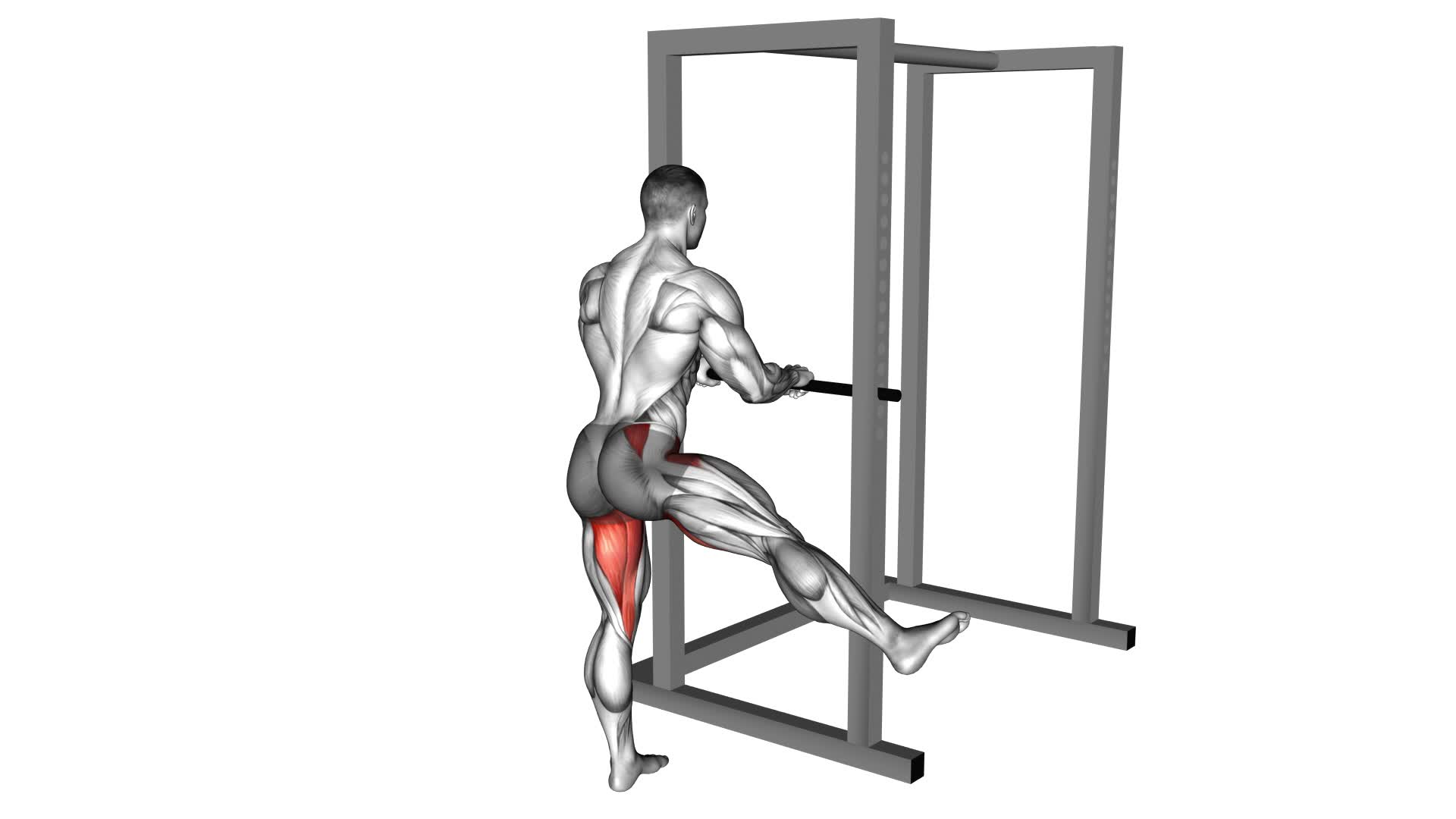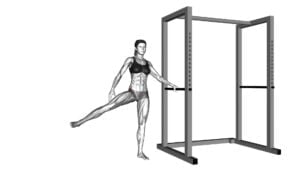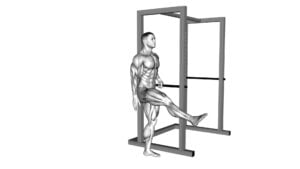Side to Side Leg Swings (male) – Video Exercise Guide & Tips

Are you looking for a dynamic exercise to strengthen your legs? Look no further than side to side leg swings.
Watch This Exercise Video
This simple yet effective movement targets multiple muscles, helping you build strength and flexibility. In this video exercise guide, we'll show you the proper form and technique, as well as common mistakes to avoid.
Get ready to maximize your workout results with these tips and variations. Let's swing those legs side to side and feel the burn!
Key Takeaways
- Side to side leg swings improve hip mobility and flexibility.
- They target muscles in the hips, thighs, and glutes.
- Leg swings increase range of motion and overall strength.
- They activate muscles for other lower body exercises and act as a warm-up for targeted muscles.
Benefits of Side to Side Leg Swings
The benefits of performing side to side leg swings include improving hip mobility and flexibility. This exercise specifically targets the muscles in your hips, thighs, and glutes, helping to increase their range of motion and overall strength. Side to side leg swings not only warm up these muscles but also activate them for other lower body exercises.
To perform side to side leg swings, stand with your feet shoulder-width apart and your hands on a wall or a sturdy support for balance. Swing one leg out to the side as far as comfortable, while keeping your upper body stable and your core engaged. Then, swing your leg back across your body, allowing it to cross in front of the opposite leg. Repeat this swinging motion for the desired number of repetitions, and then switch to the other leg.
While side to side leg swings offer many benefits, it's important to take certain precautions. Always start with a gentle swing and gradually increase the range of motion to avoid straining your muscles. Additionally, be mindful of your body's limitations and never force any movement that causes pain or discomfort.
Incorporating side to side leg swings into your exercise routine can help improve your hip mobility and flexibility, while targeting the muscles in your hips, thighs, and glutes. Remember to take precautions and listen to your body to ensure a safe and effective workout.
Proper Form and Technique
To execute side to side leg swings properly, assume a shoulder-width stance with your hands on a wall or sturdy support for balance. This position ensures stability and allows you to focus on the exercise. As you swing your leg to the side, keep it straight and engage your core for stability.
The movement should come from your hip joint, not your lower back. Swing your leg across your body, aiming for a comfortable range of motion. This exercise is great for improving flexibility in your hip adductors and abductors, which can help prevent injuries such as groin strains and hip imbalances.
By regularly incorporating side to side leg swings into your routine, you can maintain a healthy range of motion in your hips and lower body, which is essential for overall fitness and injury prevention.
Now, let's move on to the next section to discuss common mistakes to avoid when performing side to side leg swings.
Common Mistakes to Avoid
To avoid common mistakes while performing side to side leg swings, focus on maintaining proper alignment and avoiding unnecessary movement. One common mistake is swinging the legs too forcefully, which can strain the hip joint and lead to injury. Remember, the goal is to gently swing the legs from side to side, using controlled movements and engaging the core muscles for stability.
Another common misconception is arching the back or leaning too far forward during the exercise. This can put excessive strain on the lower back and compromise form. Instead, keep the back straight and the core engaged throughout the movement.
Additionally, avoid using momentum to swing the legs. It's important to rely on the strength of the hip and glute muscles to initiate the movement, rather than relying on momentum. By focusing on proper alignment and avoiding unnecessary movement, you can maximize the benefits of side to side leg swings while minimizing the risk of injury.
Now that you understand the common mistakes to avoid, let's explore some variations and modifications of side to side leg swings.
Variations and Modifications
To add variety and challenge to your side to side leg swings, you can incorporate different variations and modifications into your routine. Here are some alternative exercises and progression options to consider:
- Front to back leg swings: Instead of swinging your leg from side to side, swing it forward and backward. This variation targets different muscles and helps improve hip mobility.
- Weighted leg swings: Hold a dumbbell or kettlebell in your hand while performing the leg swings. This added resistance increases the difficulty and engages your muscles even more.
- Lateral leg swings with resistance band: Attach a resistance band to a stable object and loop it around your ankle. Swing your leg laterally against the resistance of the band to strengthen your hip abductors.
- Single-leg swings: Perform the leg swings on one leg at a time to challenge your balance and stability.
By incorporating these variations and modifications, you can keep your workouts fresh and continue challenging your muscles.
Now, let's move on to the next section to learn some tips for maximizing your results.
Tips for Maximizing Results
To maximize your results and get the most out of your side to side leg swings, focus on proper technique and form. Before starting any exercise, it's important to warm up your muscles to prevent injury and improve performance. Incorporating effective warm-up exercises like jogging in place or dynamic stretching can help prepare your body for the leg swings.
When performing side to side leg swings, stand tall with your feet shoulder-width apart. Keep your core engaged and maintain a slight bend in your knees. Begin by swinging one leg laterally across your body, aiming to reach as high as comfortable without straining. As you swing your leg back, allow it to swing freely and naturally, without forcing it. Repeat the motion for the desired number of reps, then switch to the other leg.
To incorporate leg swings into your workout routine, consider adding them as part of your lower body or dynamic warm-up routine. They can be performed before activities such as running, squatting, or lunging to activate and mobilize the hip and leg muscles. Remember to start with a lighter intensity and gradually increase as your muscles become more accustomed to the exercise.
Frequently Asked Questions
How Many Repetitions of Side to Side Leg Swings Should I Do?
To get the most out of side to side leg swings, it's important to know the proper form and how many repetitions to do.
Side to side leg swings can improve flexibility, increase range of motion, and strengthen your hip muscles.
To perform them correctly, stand with your feet shoulder-width apart and swing one leg out to the side, then back across your body.
Aim for 10-15 repetitions on each leg, but listen to your body and adjust as needed.
Can Side to Side Leg Swings Help Improve Flexibility?
Side to side leg swings can definitely help improve flexibility, especially for athletes. This exercise targets the hip muscles, increasing their range of motion and overall flexibility.
To perform side to side leg swings correctly, stand tall with one hand on a stable surface for balance. Swing one leg out to the side, keeping it straight and controlled. Repeat on the other side.
Remember to engage your core and maintain proper form throughout the exercise.
Are Side to Side Leg Swings Suitable for Individuals With Knee Injuries?
For individuals with knee injuries, it's important to consider alternatives to side to side leg swings. These exercises can put strain on the knees and potentially worsen the injury.
Instead, focus on low-impact exercises like seated leg lifts or stationary biking.
If you still want to incorporate leg swings, take precautions and modify the movement. Start with smaller swings and gradually increase the range of motion.
Listen to your body and stop if you feel any pain or discomfort.
Can Side to Side Leg Swings Be Incorporated Into a Warm-Up Routine?
Incorporating dynamic stretches into your warm-up routine offers several benefits. It helps improve flexibility, increases blood flow to your muscles, and prepares your body for more intense exercise.
If side to side leg swings aren't suitable for you, there are alternatives to warm up your lower body. Try exercises like high knees, leg swings forward and backward, or walking lunges.
These movements will effectively warm up your muscles and joints before your workout.
What Muscles Are Targeted During Side to Side Leg Swings?
During side to side leg swings, several muscles are targeted, providing benefits for athletes. This exercise primarily works the hip abductors and adductors, which are responsible for moving the legs sideways. By strengthening these muscles, athletes can improve their stability, balance, and agility, making them more efficient in sports that involve lateral movements.
For beginners, modifications can be made by reducing the range of motion or performing the exercise with support, such as holding onto a stable surface for balance.
Conclusion
Incorporating side to side leg swings into your workout routine can bring numerous benefits. These include improved hip flexibility and increased range of motion. To ensure proper form, keep your core engaged and swing your leg smoothly from side to side.
Avoid common mistakes like arching your back or swinging too forcefully. These can lead to poor form and potential injury. By maintaining control and focusing on the targeted muscles, you can maximize the effectiveness of the exercise.
To further enhance your results, try different variations and modifications. For example, you can add ankle weights to increase resistance and challenge your muscles even more. Additionally, performing the exercise on an unstable surface, such as a balance board or foam pad, can engage your stabilizer muscles and improve overall balance.
Remember to keep practicing and enjoy the benefits of this simple yet effective exercise. Regularly incorporating side to side leg swings into your routine can help you achieve greater flexibility and mobility, leading to improved performance in various activities and reduced risk of injury.

Author
Years ago, the spark of my life’s passion ignited in my mind the moment I stepped into the local gym for the first time. The inaugural bead of perspiration, the initial endeavor, the very first surge of endorphins, and a sense of pride that washed over me post-workout marked the beginning of my deep-seated interest in strength sports, fitness, and sports nutrition. This very curiosity blossomed rapidly into a profound fascination, propelling me to earn a Master’s degree in Physical Education from the Academy of Physical Education in Krakow, followed by a Sports Manager diploma from the Jagiellonian University. My journey of growth led me to gain more specialized qualifications, such as being a certified personal trainer with a focus on sports dietetics, a lifeguard, and an instructor for wellness and corrective gymnastics. Theoretical knowledge paired seamlessly with practical experience, reinforcing my belief that the transformation of individuals under my guidance was also a reflection of my personal growth. This belief holds true even today. Each day, I strive to push the boundaries and explore new realms. These realms gently elevate me to greater heights. The unique combination of passion for my field and the continuous quest for growth fuels my drive to break new ground.







